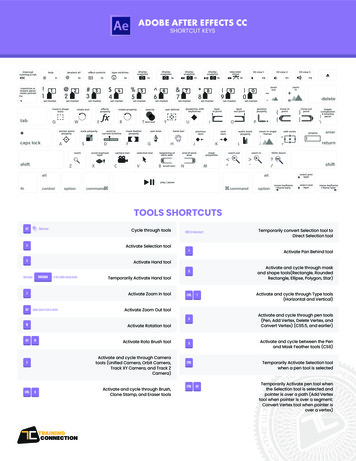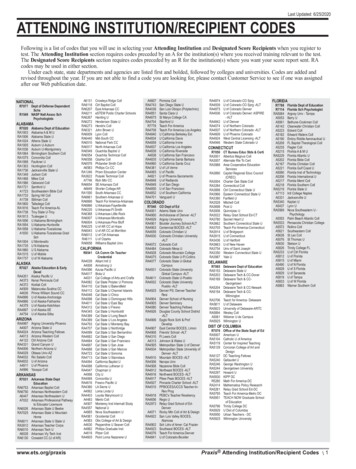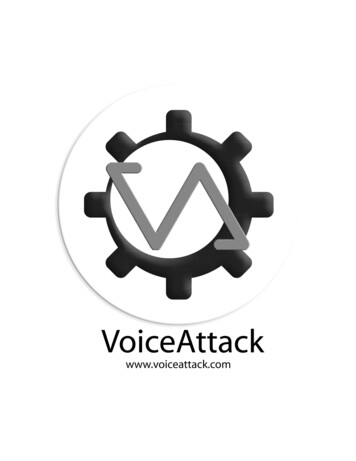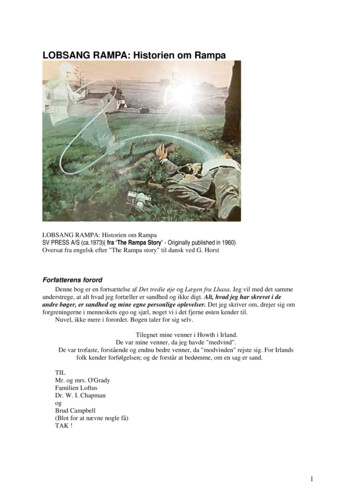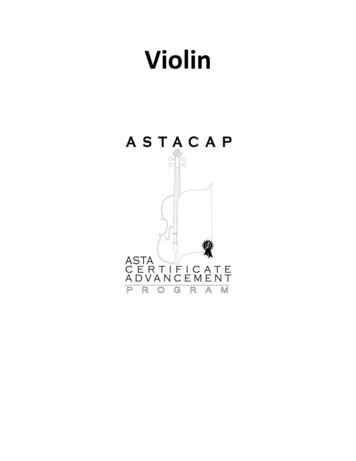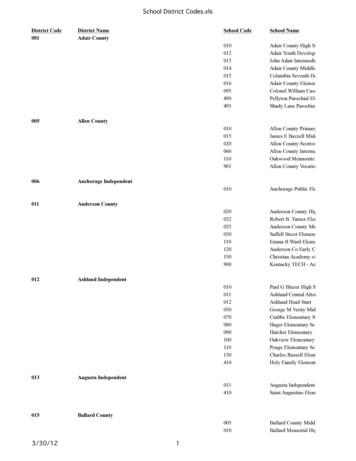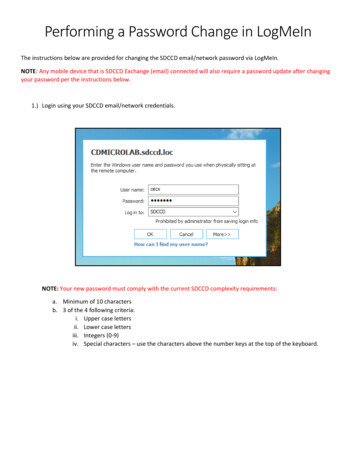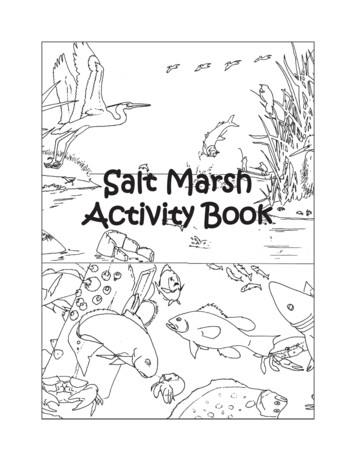
Transcription
Salt MarshActivity Book
This activity book supplements the Guide to the Salt Marshes andTidal Creeks of the Southeastern United States publication that wascreated for the From Seeds to Shorelinesm education program. Foronline access to the Guide, and for more information about the FromSeeds to Shorelinesm program, please visit the websites below.Guide: www.saltmarshguide.comFrom Seeds to Shorelinesm: www.scseagrant.org/education
Salt Marsh Activity BookCatharine Parker, Denise Sanger, Julie Binz, and Elizabeth GoodingSouth Carolina Department of Natural ResourcesElizabeth Vernon BellSouth Carolina Sea Grant ConsortiumKim Counts MorganelloClemson ExtensionAcknowledgementsErin Koch: salt marsh abundance map (p. 1)SCDNR: life in the salt marsh (cover and p. 7)Elizabeth Gooding: all other hand drawn plant and animal drawingsCopyright South Carolina Department of Natural ResourcesAll rights reservedPrinted by theSouth Carolina Department of Natural Resources1000 Assembly Street, Columbia, SC 29201www.dnr.sc.govNot intended for saleThe South Carolina Department of Natural Resources prohibits discrimination on the basis of race, gender, color, national origin, religion, disability or age.Direct inquiries to the Office of Human Resources, P.O. Box 167, Columbia, S.C. 29202.Total copies: 5,000Total cost: 3,222.00Cost per copy: 0.64
Salt Marsh Activity BookWhat is a salt marsh?The salt marsh is an ecosystem that is found along thecoast near the waters of the estuary. An estuary iswhere rivers (freshwater) meet the sea (salt water).Daily tides move water in and out of the salt marshecosystem, causing the area to be flooded during certainparts of the day.Salt marshes can be foundall the way from Maine toFlorida along the east coastof the United States. Mostof the salt marsh habitatis in the Southeast. SouthCarolina and Georgia eachhave about 350,000 acresof salt marshes; NorthCarolina has about 225,000acres; the northeast Floridacoast has about 83,000acres.Map of Southeastern salt marsh abundanceFun Fact: Together, North Carolina, South Carolina,Georgia, and northeast Florida have almost two-thirdsof the salt marsh habitat found along the east coast!1
Salt Marsh Activity BookBenefits of the salt marshSalt marshes are helpful in many ways including keepingour water clean, protecting us from flooding, providinghabitat for animals and plants, and supporting funactivities. Some of the main benefits the salt marshprovides to people are: Clean Water - A healthy salt marsh removespollution from the water. This makes it safe for usto swim and fish. Flood Protection - Salt marsh plants and oysterreefs help stop strong waves that happen duringstrong storms, such as hurricanes. This helpsprotect our land and houses from flooding. Seafood - The salt marsh provides a habitat formany of the animals humans eat for food includingoysters, crabs, and fish. Some people have jobscatching these animals to sell to other people. Recreation - People spend hours enjoying the saltmarsh ecosystem. Some people fish while othersspend their time kayaking or bird watching.How does a salt marsh help you?2
Salt Marsh Activity BookThreats to the salt marshOver half of the people in the United States live alongthe coast. Because of the natural beauty of the saltmarsh, many people want to live near it. It is importantto protect this ecosystem so that others can enjoy themarsh now and in the future. Some of the main threatsto the salt marsh are: Development - Roads, parking lots, and rooftopsdo not let rainfall drain into the soil. Instead, therainfall runs off into nearby marshes, carryingpollution with it. Some examples of pollution includelitter, oil/gas, and pet waste. Litter - Trash that gets washed into the salt marshcan trap animals and crush plants. It can also breakinto small pieces that animals eat, making them sick. Invasive species - Some plants and animals we seein the salt marsh are not supposed to live there.These are called invasive species and they competewith other plants and animals for food and habitat. Sea level rise - As our planet warms up, glaciersmelt and flow into our ocean. This causes our seas torise, which could lead to our salt marshes drowning.Can you think of other threats to the salt marsh?3
Salt Marsh Activity BookSalt marsh word searchCan you find all the salt marsh words in the puzzle below?Words will go from left to right and from top to RZRIVQEBDSHCXKSGJYBHLROPVDOLPHINBIRDPLUFF MUDCORDGRASSSALT MARSHDOLPHINSHARKESTUARYSNAILFISHTIDAL CREEKOYSTERTIDES4
Salt Marsh Activity BookCan you draw animals in the salt marsh?Can you draw things that do not belong?5
Salt Marsh Activity BookSmooth cordgrassSpartina alternifloraSpartina is a grass found throughout the salt marsh,and changes colors depending on the season.Spartina can survive in salt water and live along tidalcreeks because of special adaptations.Fun fact: Spartina can grow nearly 8 feet tall!Which seasons do you think Spartina is bright green?Answer: Spring and Summer6
Salt Marsh Activity BookPhytoplanktonPhytoplankton are free-floating plants or algae at thebottom of the food chain. They drift with the currentsin both fresh and salt water, and can cling to Spartinablades where they are eaten by grazing periwinkle snails.Fun fact: Phytoplankton produce most of the oxygenthat we breathe!ZooplanktonZooplankton are tiny animals that drift with the currents.Together, zooplankton and phytoplankton form the baseof the food chain.Fun fact: Some zooplankton grow into larger animals,such as fish and crabs!7
Salt Marsh Activity BookAnnelid wormsAnnelids are any worms with sections on their body.Some of the worms you may see in the salt marsh arelike the earthworms you dig up in your yard.Fun fact: Some salt marsh worms move through themud to feed while others create tubes to live in andwait for food to pass by their mouths!8
Salt Marsh Activity BookEastern oysterCrassostrea virginicaOysters have two shells that open to feed and close toprotect themselves from drying out at low tide.Oysters grow together to form a reef, which provideshabitat for many fish, worms, and crabs!Fun fact: Adult oysters can filter up to four gallons ofwater an hour which helps keep our water clean!Where do you find oysters in the salt marsh?Answer: In tidal creeks9
Salt Marsh Activity BookMarsh periwinkleLittoraria irrorataThe marsh periwinkle is a snail that has a dark brownto white shell.Periwinkle snails climb up Spartina grass at high tideto escape being eaten and to feed.Fun fact: Some periwinkle snails spend their entirelife on one blade of Spartina !What do you think eats periwinkle snails?Answer: Blue crabs and diamondback terrapins10
Salt Marsh Activity BookKnobbed whelkBusycon caricaKnobbed whelks can be found in tidal creeks, oftennear oyster reefs.Knobbed whelks lay a string of eggs, which often getwashed up on the beach.Fun fact: Knobbed whelks are born with a shell, andas the body grows, the shell grows with it in a spiral!What do you think knobbed whelks eat?Answer: Clams, mussels, and oysters11
Salt Marsh Activity BookMud fiddler crabUca pugnaxMud fiddler crabs have eyes at the end of long stalksand a light "H" shape on their back.Mud fiddler crabs dig small holes in the mud, and youcan often see small balls of mud near the opening.Fun fact: Males have one large and one small claw andfemales have two small claws!Is the mud fiddler crab above a male or female?Answer: Male12
Salt Marsh Activity BookBlue crabCallinectes sapidusBlue crabs have a pair of paddle-like legs used forswimming, and three pairs of legs used for walking.Blue crabs are found in many habitats and are scavengers,meaning they eat whatever they can find.Fun fact: The tips of male claws are blue and the tipsof female claws are red!Can you circle the legs used to swim?Answer: The two legs on the bottom13
Salt Marsh Activity BookWhite shrimpPenaeus setiferusShrimp have long white bodies with black speckles anddark eyes in the shape of kidney beans.Shrimp move around, young shrimp can be found way upthe tidal creeks, then move into the ocean as they grow.Fun fact: Shrimp have two types of legs - some legs areused for walking and some legs are used for swimming!Can you circle the legs that are used for walking?Answer: The thin legs closest to the head14
Salt Marsh Activity BookSalt marsh grasshopperOrchelimum fidiciniumThe salt marsh grasshopper is similar to the grasshoppersyou may see in your yard.Salt marsh grasshoppers have two long antennae and arebright green all over their body and legs.Fun fact: Salt marsh grasshoppers are one of the onlyanimals that eat live Spartina!Why are salt marsh grasshoppers bright green?Answer: To camouflage with Spartina15
Salt Marsh Activity BookDiamondback terrapinMalaclemys terrapinDiamondback terrapins have a diamond shaped patternon their shell.A diamondback terrapin female will only crawl out of thewater when it is time to lay her eggs.Fun fact: Every diamondback terrapin is different, theirbodies can be black, gray, green, brown, or spotted!Is the terrapin a type of turtle, fish, or bird?Answer: Turtle16
Salt Marsh Activity BookRed drumSciaenops ocellatusRed drum are a long, light red fish and have one or moredark spots near the tail.Many fishermen hope to catch red drum when they visitthe salt marsh to fish.Fun fact: The spot on the tail looks like an eye, so otherfish will attack the tail thinking it is the head!Can you find the eye spots?Answer: The dark spots on the tail17
Salt Marsh Activity BookAtlantic croakerMicropogonias undulatusThe Atlantic croaker is a silver fish with light blackstripes on the sides of its body.The Atlantic croaker has a black spot located at thebase of the pectoral fins (side fins).Fun fact: The Atlantic croaker makes a loud croakingsound which can be heard if it is caught while fishing!Why do you think it croaks when it is caught?Answer: Because it is stressed18
Salt Marsh Activity BookSheepsheadArchosargus probatocephalusSheepshead are thin fish, which swim around docks andoyster reefs in the water.Sheepshead have dark thick stripes running down bothsides of their body.Fun fact: Sheepshead have large teeth like human teethwhich crush shells and scrape food off of docks!What do you think the darker stripes are for?Answer: Camouflage19
Salt Marsh Activity BookSummer flounderParalichthys dentatusThe summer flounder is a flat fish with both eyes on thesame side of its body.Flounders can camouflage with the sand or mud on thebottom of the creek.Fun fact: A flounder is born with eyes on both sides ofits head. As it grows, one eye moves to the other side!What color is a flounder when it blends in with mud?Answer: Brown20
Salt Marsh Activity BookAtlantic sharpnose sharkRhizoprionodon terraenovaeThe Atlantic sharpnose shark has a long thin body, thatis dark on top and light on the bottom.Like all sharks, the skeleton of the Atlantic sharpnoseshark is made of cartilage (like your nose), not bone.Fun fact: The Atlantic sharpnose shark is called "thedeer of the marsh" because of how many there are!Can you circle where the gills are located?Answer: The gills are the slits near the head21
Salt Marsh Activity BookAtlantic stingrayDasyatis sabinaThe Atlantic stingray is a flat, round fish that is dark onthe top and light on the bottom.The holes on top of the Atlantic stingray's head suck inwater to breathe while it is buried on the bottom.Fun fact: The Atlantic stingray does not use its spineto attack; it only uses it for defense when it is scared!Where do you think an Atlantic stingray's mouth is?Answer: On the bottom of its body22
Salt Marsh Activity BookGreat blue heronArdea herodiasThe great blue heron is a very tall bird that can growup to 4 feet tall.Great blue herons are wading birds, meaning they walkthrough the water to feed.Fun fact: Although the great blue heron is large, itonly weighs between 5-6 pounds!What do you think the great blue heron eats?Answer: Fish and shrimp23
Salt Marsh Activity BookBrown pelicanPelecanus occidentalisBrown pelicans are a large diving bird with a white headand brown body.The pelican's long bill has a large pouch named a "gular,"which is used to scoop up fish.Fun fact: Like some humans, as pelicans age, the colorof their head turns to white!Where do you think the pelican's pouch is?Answer: Hidden beneath its beak24
Atlantic stingrayStone crabBlack sea bassWhite shrimpAtlantic sharpnose shark Great blue heronSmooth cordgrassFiddler crabSnowy egretRibbed musselEastern oysterBlue crabMarsh periwinkleKnobbed whelkBarnacleAnswers: column one (1, 14, 7, 15, 23, 6, 28, 4); column two (26, 11, 18, 22, 25, 16, 30, 3); column three (19, 10, 27, 21, 5, 20, 8, 31)26American oystercatcherRed drumSummer flounderBottlenose dolphinBrown pelicanStriped mulletHard clamStriped hermit crabSalt marsh grasshopperCan you find the animal above and put the numbernext to its name below?Salt Marsh Activity Book
Salt Marsh Activity BookSalt marsh food webA food web is a never ending cycle of "what eats what."Predators hunt other animals for food, and prey areanimals that are hunted. Below, an arrow drawn from aprey to a predator means that the predator eats thatprey. For example, an arrow from the periwinkle snail tothe terrapin means the terrapin eats periwinkle snails!27
Salt Marsh Activity BookMake your own food webUse the animals found in this book to make your ownfood web. Try to include a mix of predators and prey!Remember to draw your arrows from prey to predator.28
Salt Marsh Activity BookSalt marsh cryptogramBelow you see all the letters of the alphabet with a boxbelow it. Each letter has a number that goes with it. Usethe information given to fill in the letters on the linesbelow to solve the phrase!ABCDEFG HIJKL M N OP22467316 23 20 12 142521 19 24 25 13 10 15 181718Q RST UV W XHave you seen a salt marsh? Where?How can you help protect the salt marsh?What is your favorite animal in the salt marsh?299YZ11 26
Salt Marsh Activity BookReferences and additional resourcesReference BooksHayes, M., J. Michel, and J. Holmes. 2008. A Coast for All Seasons: A Naturalist‛sGuide to the Coast of South Carolina. Pandion Books. Columbia, SC. 288 pp.Porcher, R. and D. Rayner. 2002. A Guide to the Wildflowers of South Carolina.University of South Carolina Press. Columbia, SC. 544 pp.Porcher, R. and W. Judd. 2014. The Market Preparation of Carolina Rice: AnIllustrated History of Innovations in the Lowcountry Rice Kingdom. Universityof South Carolina Press. Columbia, SC. 379 pp.Seabrook, C. 2012. The World of the Salt Marsh: Appreciating and Protecting theTidal Marshes of the Southeastern Atlantic Coast. University of GeorgiaPress. Athens, GA. 367 pp.Tiner, R. W. 2013. Tidal Wetlands Primer - An Introduction to Their Ecology, NaturalHistory, Status, and Conservation. University of Massachusetts Press. Boston,MA. 508 pp.Tuten, J. H. 2010. Lowcountry Time and Tide. University of South Carolina Press.Columbia, SC. 200 pp.Wiegert, R. and B. Freeman. 1990. Tidal Salt Marshes of the Southeast AtlanticCoast: A Community Profile. Fish and Wildlife Service, U.S. Department ofthe Interior. Washington, D.C. 70 pp.Children‛s/Educational MaterialAlber, M. and J. Turley. 2012. And the Tide Comes In. Exploring a Georgia SaltMarsh. Taylor Trade Publishing. Lanham, MD. 32 pp.Bryant, D., G. Davidson, and C. Ingram. 2003. Georgia‛s Amazing Coast. Universityof Georgia Press. Athens, GA. 112 pp.Bryant, D., G. Davidson, T. Kirby Hathaway, and K. Angione. 2013. North Carolina‛sAmazing Coast. University of Georgia Press. Athens, GA. 102 pp.DeVictor, S., D. Knott, and S. Crowe. 2010. South Carolina Beachcomber‛s Guide - AGuide to Common Invertebrates, Plants and Natural Artifacts of the SouthCarolina Seashore. South Carolina Department of Natural Resources.Charleston, SC. 93 pp.Farmer, C. and B. Fowler. 2005. Your Key to Identifying Sharks of South Carolina.South Carolina Department of Natural Resources. Charleston, SC. 48 pp.Holland, F. and D. Sanger. Tidal Creek Habitats: Sentinels of Coastal Health. NationalOceanic and Atmospheric Administration and SC Sea Grant Consortium. 22 pp.Keener-Chavis, P. and L. Sautter. 2002. Of Sand and Sea: Teachings From theSoutheastern Shoreline. SC Sea Grant Consortium. Charleston, SC. 76 pp.Kurtz, K. 2007. A Day in the Salt Marsh. Sylvan Dell Publishing. Mt. Pleasant, SC. 32 pp.SCDNR. 2013. Sea Science. An Information and Education Series from the MarineResources Division. South Carolina Department of Natural Resources. Charleston,SC. http://www.dnr.sc.gov/marine/publications.html30
Salt Marsh Activity BookWebsitesFrom Seeds to Shoreline (S2S) Program: www.scseagrant.org/educationUS Environmental Protection Agency: www.epa.govNC Sea Grant: www.ncseagrant.orgSC Sea Grant Consortium: www.scseagrant.orgGA Sea Grant: www.georgiaseagrant.uga.eduMarine Education Extension Program: www.marex.uga.eduFL Sea Grant: www.flseagrant.orgNC Department of Environmental Quality: www.ncdenr.govSC Department of Natural Resources: www.dnr.sc.govSCDNR Southeastern Regional Taxonomic Center:www.dnr.sc.gov/marine/sertcSC Department of Health & Environmental Control: www.scdhec.govGA Department of Natural Resources: www.gadnr.orgFL Department of Environmental Protection: www.dep.state.fl.usNational Estuarine Research Reserve (NERR) System: www.nerrs.noaa.govNC Coastal Reserve and NERR: www.nccoastalreserve.net/web/crpNorth Inlet-Winyah Bay NERR: www.northinlet.sc.eduACE Basin NERR: www.dnr.sc.gov/marine/NERR/index.htmlSapelo Island NERR: www.sapelonerr.orgGuana Tolomato Matanzas NERR: www.gtmnerr.orgClemson Carolina Clear: www.clemson.edu/carolinaclearTeachers on the Estuary (TOTE), Estuaries al Carolina Discovery Program: www.dnr.sc.gov/ccdSC Aquarium: www.scaquarium.orgNC Aquariums: www.ncaquariums.comGA Aquarium: www.gaaquarium.orgBrevard County Environmentally Endangered Lands Program:www.brevardcounty.us/eelprogram/homeGullah Geechee Cultural Heritage Corridor: www.gullahgeecheecorridor.org31
Salt Marsh Activity BookSCDNR Mission StatementThe South Carolina Department of Natural Resources is the advocate for and stewardof the state‛s natural resources. The South Carolina Department of Natural Resourcesdevelops and implements policies and programs for the conservation, management,utilization and protection of the state‛s natural resources based upon scientificallysound resource assessment and monitoring, applied research, technology transfer,comprehensive planning, public education, technical assistance and constituentinvolvement. The South Carolina Department of Natural Resources is pro-active inprotecting the state‛s natural resources for use and enjoyment by future generationsof South Carolinians.SCDNR PledgeMembers of the public are of utmost importance to us, whether in the office or thefield. We must listen to their concerns and balance their needs with those of thestate‛s natural resources, for which we are accountable. In essence, they are ouremployers, and we should treat them with the dignity that such a position affords.Funding for the development and printing of the coloring book was provided underAssistant Agreement No. NE-00D19914 awarded by the U.S. Environmental ProtectionAgency. It has not been formally reviewed by USEPA. The views expressed are solelythose of SC Department of Natural Resources and SC Sea Grant Consortium. USEPAdoes not endorse any products or commercial services mentioned.32
Printed on recycled paper16-11155
Salt Marsh Activity Book TThreats to the salt marshhreats to the salt marsh Over half of the people in the United States live along the coast. Because of the natural beauty of the salt marsh, many people want to live near it. It is important to protect this ecosystem so that others can enjoy


